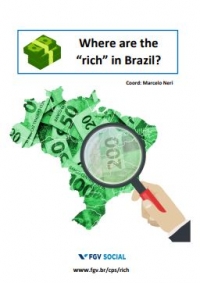
Where are the “rich” in Brazil?
About the research:
According to estimates from FGV Social based on declared earnings in Income Tax registries over total population projections in each locality, the Brazilian State’s Capital with the highest income per inhabitant is Florianópolis (R$ 3,998/month), followed by Porto Alegre and Vitória. Then, the ranking continues with São Paulo (4th), Curitiba (5th), Brasília (6th) and Rio de Janeiro (7th). When assessing the 27 Units of the Federation (also known as the Brazilian States), the axis Federal District–São Paulo–Rio de Janeiro assumes the top three places in the ranking, respectively. Brasília’s mean declared income is R$ 2,981, but this estimate includes all citizens living in the city, in other words, it was not exclusively based on those individuals who had declared their earnings to the Brazilian Revenue Office. If we only consider the declarants in our estimates, Brasília’s mean income increases to R$ 11,994. At South Lake, the richest Administrative Region in the city and home of the richest public servants in the country, declarants’ mean income reaches R$ 38,460, while the mean declared income per inhabitant is R$ 23,020. There is no single municipality in Brazil that surpasses this income threshold.
In other words, Brasília is the Unit of the Federation with the highest income and its South Lake district has three times the income of the richest Brazilian municipality. Regarding inequality between the Brazilian States, evidence shows that Brasília’s mean income is 8 times higher than in Maranhão, the poorest Unit of the Federation with only R$ 363/month. Moreover, 17 out of the 27 Units of the Federation have a mean income below R$ 1000, none of them in the South or Southeast regions. When looking at data for Brazilian States’ Capitals, the two richest Capitals are in the South region, while the poorest five are in the North Region of the country, with Macapá at the very end. These results suggest that North-South comparisons are truly important to understand the main income differences in the country.
The ranking of occupations shows that six out of the ten better-paid jobs are related to the public sector, according to Income Tax data. Therefore, the evidence shows that an administrative reform in the Brazilian public sector is indeed necessary. Evidence from Income tax registries also gives us insights for tax reforms aiming a more progressive tax scheme. The top-3 richest municipalities among all 5570 Brazilian municipalities are relatively small cities: Nova Lima (MG), Santana do Parnaíba (SP) and Aporé (GO). In addition to coastal cities such as Florianópolis, Vitória, Niterói and Santos, which usually attract the richest strata of the population since individuals with higher purchasing power usually prefer to live in cities with a higher quality of life, including (but not limited to) more economic opportunities. This phenomenon also happens because there are more job opportunities for doctors, lawyers, and liberal professionals in places with rich people. Thus, in our assessment, we have explored the lifestyle of the richest Brazilians.
Data from Income Tax registries assembled by the Brazilian Revenue Office allow us to better assess the income concentrated at the top of the income distribution when compared to household surveys, which usually underpin researches on poverty and inequality. Consequently, we can think of the eligibility criteria for filing Income Tax as a kind of “wealth line” that allows us to identify the Brazilian citizens with the highest purchasing power according to the current tax legislation. This assessment might also be useful to identify new revenue sources for State actions related to Education, Health, Security and Poverty Alleviation.
Site em Português / Site in Portuguese 
Text
Slides (Visualization / Print)
Maps: Brazilian States / Capitals / Municipalities / DF
Rankings: Brazilian States / Capitals / Municipalities / DF
| Contact: marcelo.neri@fgv.br / fgvsocial@fgv.br / Tel: +5521 37992320




